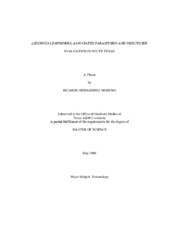LIRIOMYZA LEAFMINERS, ASSOCITED PARASITOIDS AND INSECTICIDE EVALUATION IN SOUTH TEXAS
Abstract
In the Lower Rio Grande Valley of Texas, dipterous leafminers cause damage to
pepper crop by destroying small plants (excessive mining), reduction of yield, and by
vectoring plant diseases. The objectives of the present research were to identify
leafminers species, which cause damage to peppers in South Texas, their associated
parasitoid guilds and to evaluate the efficacy of abamectin, novaluron, spinetoram and
lambda-cyhalothrin against leafminers as well as their effects on the parasitoid complex.
Field surveys were conducted on various pepper varieties in different cities of
South Texas. Insecticide evaluation was carried out on field plots in Weslaco TX using
the different insecticide treatments and water. To determine the insecticides? lethal effects
on adult leafminer parasitoids, Neochrysocharis formosa and Ganaspidium nigrimanus,
laboratory bioassays, such as topical insecticide application, pesticide intake and residual
effects were performed.
The surveys suggested that the leafminers causing the most damage to pepper
crops in South Texas is Liromyza trifolii, which represents more than 99% of the
collected and identified species. Twenty parasitoid species, of four different families,
were found to be attacking L. trifolii on pepper plants in the field. Novaluron was the most effective insecticide in controlling L. trifolii, followed by spinetoram and abamectin.
Lambda-cyhalothrin was the least effective, showing L. trifolii tolerance to the compound.
In field evaluation novaluron showed the lowest parasitoid: leafminer larvae ratio and
parasitoid diversity index. In contrast, novaluron had the least impact on adult parasitoids
in laboratory bioassays compared with other treatments (abamectin, spinetoram, lambdacyhalothrin).
The lambda-cyhalothrin showed negative effects only to Ganaspidium
nigrimanus in topical assays, but in the residual assays it had negative effects on G.
nigrimanus as well as N. formosa. On the other hand, abamectin showed negative effects
on N. formosa and G. nigrimanus in the topical and intake bioassays and negative effects
on G. nigrimanus but no-effect on N. formosa in the residue bioassay. Furthermore
spinetoram showed negative effects on N. formosa and G. nigrimanus in all bioassays
carried out in the laboratory. Leafminer species, parasitoid species composition, efficacy
of insecticides, effects of insecticides on parasitoids and development of tolerance to
lambda-cyhalothrin by L. trifolii and N. formosa were discussed.
Citation
Hernandez Moreno, Ricardo (2009). LIRIOMYZA LEAFMINERS, ASSOCITED PARASITOIDS AND INSECTICIDE EVALUATION IN SOUTH TEXAS. Master's thesis, Texas A&M University. Available electronically from https : / /hdl .handle .net /1969 .1 /ETD -TAMU -2009 -05 -540.


